 SMS Bussard, Falke, Seeadler, Condor, Cormoran, Geier
SMS Bussard, Falke, Seeadler, Condor, Cormoran, GeierWW1 German Cruisers
Irene class | SMS Gefion | SMS Hela | SMS Kaiserin Augusta | Victoria Louise class | Prinz Adalbert class | SMS Prinz Heinrich | SMS Fürst Bismarck | Roon class | Scharnhorst class | SMS BlücherBussard class | Gazelle class | Bremen class | Kolberg class | Königsberg class | Nautilus class | Magdeburg class | Dresden class | Graudenz class | Karlsruhe class | Pillau class | Wiesbaden class | Karlsruhe class | Brummer class | Königsberg ii class | Cöln class
The last German sailing Cruisers
In 1914, among the oldest vessels of the Reichsmarine were the remainder of late 1880s colonial “cruisers” of the Bussard class. All named after marine birds, these fourth class cruisers, were more gunboats-size as per WWI standards. They had a barquentine rig, ram bows, clipper stern, wooden sheating to diffuse the metal heat in tropical waters. Although plans were similar, they diverged among their builder yards, between Dantzig, Kiel, Blohm & Voss, Wilhelmshaven Dyd. Laid down in 1888 to 1893, they were launched in 1890-94, completed in 1890-95.
Falke and Condor were not rebuilt, the other being refitted in 1898-1909, two discarded in 1913, two (Seeadler and Condor) hulked in 1914, but SMS Cormoran was still active, caught in Tsingtao when the Japanese besieged the only Asian German port. She was scuttled on 28.9.1914 to avoid capture. In 1917, SMS Seeadler was a mine hulk, and blew up in the Jade by accident. SMS Condor survived the war. SMS Geier carried Adimral Graf Von Spee to the East Asia squadron and later arrived too late to do anything on the besieged Tsingtao. She was to sail to South America by ended in the Marshall Islands, an then Honolulu, interned. She served as USS Schurz until 1918, rammed and sank by the merchant ship SS Florida.
Design
Germany built two types of cruising vessels in the 1870-80s, either small and fast avisos used as fleet scouts and long-range screw and fully rigged corvettes designed for the growing German colonial empire. Two new cruisers were authorized under the 1886–1887 fiscal year for colonial service under General Leo von Caprivi (Chief of the Imperial Admiralty) participated in the early draft and specifications of the two Schwalbe-class unprotected cruisers, later forerunners of the larger Bussard class as known today by naval historians. The Schwalbe would be seen in a separate post in the 1890 German Navy.
The next Bussard class basic design was prepared in 1888. They were larger and faster than the Schwalbe class but with the same rigging, ram, general appearance, and battery, though with quicker-firing guns. These were also, and this needs to be underlined in contrast of many others navies including the USA, the last German fully rigged cruisers. The next Gefion was indeed steam-only.
In a general way, the five vessels had the basic same appearance and general design. They were versatile, small unprotected cruisers designed for colonial areas: Not superbly fast, range and adaptation to the tropical conditions were deciding factors here: They had economic steam engines, being decidely too slow for fleet service at 15 knots, but the rigging gave them this alternative power source extending their range.
Hull construction and general caracteristics
The cruisers’ hulls were constructed with transverse steel frames, made with yellow pine planking, up to the upper deck. Muntz metal sheathing was applied to the external and internal hull, protecting the wood from shipworm. Stem and sternposts mixed steel and timber.
They had a bronze naval ram at the bow. Divided underwater comprised ten watertight compartments plus double bottom, but only below the boiler rooms. The crew comprised 9 officers and 152 enlisted men. They also had onboard small boats comprising a steam-powered picket boat, a cutter, two yawls, and two dinghies. There was an ample rifle reserve onboard to launch landing parties if needed, easily quelling rebellions on small islands. This was helped by the fact their 3.7 cm (1.5 in) Hotchkiss revolver cannon could be dismounted and carried on the boats, but there was no dedicated wheeled mount for them when inland.
The first serie: Bussard, Falke
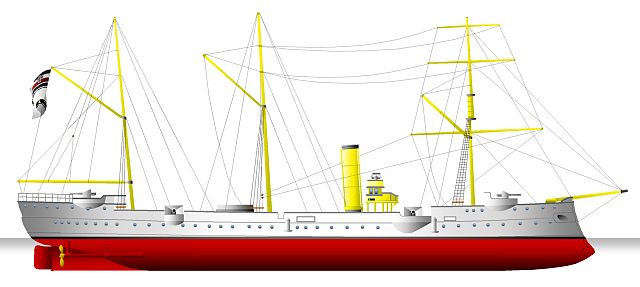
During this large gap of time the design was revised. The first batch of three (Bussard and Falke) were 1,838 tons standard, 82.6 m overall by 12.5 and 4.45 m draught. All three had two shaft HTE (Horizontal Triple Expansion) steam engines rated for 2,800 hp for 15.5 knots. They were all armed the same way with eight 105 mm guns, 5 QF revolver cannons, and two 350 mm TTs (only on Falke).
The second serie Seeadler, Condor, Cormoran
The next batch, were wider at 12.7 m and with a larger draught at 5.35 m but other specs were identical. Their TTs were upgraded to 450 mm models. Their 105 mm guns were installed by pairs forward and aft and two on the broadsides. The revolver cannons were installed amidship, as it seems.
The last: SMS Geier
Geier was laid down after all the others, as a sixth and last ship, being narrower at 10.6 m, with 5.22 m draught, but longer at 83.9 m overall, 79.62 waterline. So was also redesigned to discard the badly vibrating sponsons, curing this issue in service.
Powerplant
They all had two horizontal 3-cylinder triple-expansion steam engines. Steam came from four coal-fired cylindrical fire-tube boilers and the whole was rated at 2,800 metric horsepower (2,800 ihp). Compartimentation meant they ere separated in their own engine rooms and boilers divided into two boiler rooms, trunked into a single funnel. Propellers were a pair of 3-bladed 3 m (9 ft 10 in) diameter bronze screws.
Also, their auxiliary schooner barque rig (856 to 877 m2, 9,210 to 9,440 sq ft in toral surface area) helped them reaching 7-8 knots when wind was strong enough and granting them virtually unlimited range. The last, more modern auxiliary power source were two electric generators producing 24 kilowatts (32 hp)/67 volts combined.
Steering was controlled by a single rudder. On trials, she showed themselves as good sea boats, but rolling badly while the sponsons vibrated much, compromising their main guns accuracy. They were agile an reposnive at the helm, but turned slowly into the wind when at low speed due to their sail drag.
Top speed was 15.5 kn (28.7 km/h; 17.8 mph) as designed, exceeded on trials for all six ships: 15.7 to 16.9 knots (29.1 to 31.3 km/h; 18.1 to 19.4 mph). Fo autonomy they carried between 170 to 205 t (167 to 202 long tons; 187 to 226 short tons) of coal in peacetime, and this could rose to 305 to 320 t when filling all additional storage rooms, enough for a range between 2,990 and 3,610 nautical miles (5,540 to 6,690 km; 3,440 to 4,150 mi) at 9 knots cruiser speed.
Armament
Armament diverged between vessels as stated above:
Main battery:
8x 10.5 cm K L/35 guns (single pedestal mounts) with 800 rounds total, 8,200 m (26,902 ft 11 in) range for SMS Bussard alone.
The five next received the more modern quick-firing SK L/35 version of the same, also reaching 10,800 m (35,433 ft 1 in). They were placed side by side on the forecastle, broadside, sponson and gun port, and two on the quarterdeck.
SMS Geier as seen above had no sponsons for the second pair amidships and they were placed on the upper deck.
Light Battery:
Light gun armament comprised five 3.7 cm (1.5 in) Hotchkiss revolver cannon for all ships.
Torpedoes:
The first five had two 35 cm (13.8 in) torpedo tubes, mounted on the deck.
Geier differed by having the larger 45 cm (17.7 in) model, but they all had five torpedoes in storage.
Author’s illu of SMS Condor in 1914 after rebuilding.
⚙ Bussard class specifications |
|
| Dimensions | 82.60 x 12.50 x 4.45m (271 x 41 x 14 feets 7 in) |
| Displacement | 1,559 t standard, 1,868 t Full loaded |
| Crew | 9 officers, 152 ratings |
| Propulsion | 2 shafts TE 4 FT boilers, 2,800 shp. |
| Speed | 15.5 knots (28.7 km/h, 17.8 mph) |
| Range | 2,990 nm (5,540 km)@ 9 knots. |
| Armament | 8× 10.5 cm (4.1 in) SK L/35, 5× 3.7 cm (1.5 in) Hotchkiss, 2× 35 cm (13.8 in)TTs |
| Protection | None |
The Bussard class in action
 S.M.S. Bussard
S.M.S. Bussard

SMS Bussard was laid down at the Kaiserliche Werft, Danzig (contract “C”), launched on 23 January 1890 and completed, then commissioned on 7 October 1890. She was planned for overseas stations and was sent promptly after a short baltic shakedown, to the East Asia Station, East Asia Division. In July 1893, with SMS Falke she assisted is quelling the Mata’afa Iosefo in German-held Samoa. They also joined HMS Curacao and other vessels shelling rebels to submission on 7 July. The Mata’afa were eventually chased off from the capital, Apia, as Bussard sent like other ships a vigorous landing party. She remained behind to ensure full demilitarization of the rebels.
In 1898, SMS Bussard was back home for an overhaul, entering in March the Elbe River with tropical birds onboard for the Berlin Zoo. She was drydocked at the Kaiserliche Werft, Danzig and reconstructed with her original barque rig cut down for a simpler top-sail schooner rig (which also reduced crew), alongside a larger conning tower and bridge structure. She was ready in 1900 and after a short post-refit trials and fixes, returned to the far east, heading directly for China with the Boxer Rebellion. On 6 August 1900 while en route however, she suffered a boiler room explosion, due as it appeared later to a blown out manhole gasket. She lost three, plus three wounded (and burned). After arrival, she took part in the multinational attack on the Taku Forts with SMS Seeadler and Geier. The landing party not the crew had any casualties during the whole campaign.
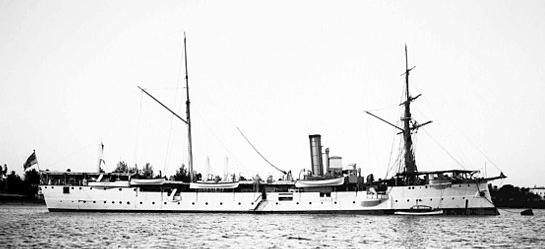
SMS Bussard in Dar es salam, 1907-14
In 1901, she was ordered to the East Africa Station (German East Africa) with the cruiser SMS Schwalbe and the gunboats SMS Habicht, Wolf stationed there already. She remained on this station in 1904, Schwalbe being replaced by Sperber. In 1908, Sperber was replaced by Bussard’s sister ship SMS Seeadler, and she remained in Africa until 1910. When back home, it was for a second and final refit. She stayed in Germany however for a short time: New, more modern and far more impressive cruisers were in completion and needed a crew: SMS Bussard was therefore stricken on 25 October 1912, broken up in 1913 in Hamburg.
 S.M.S. Falke
S.M.S. Falke
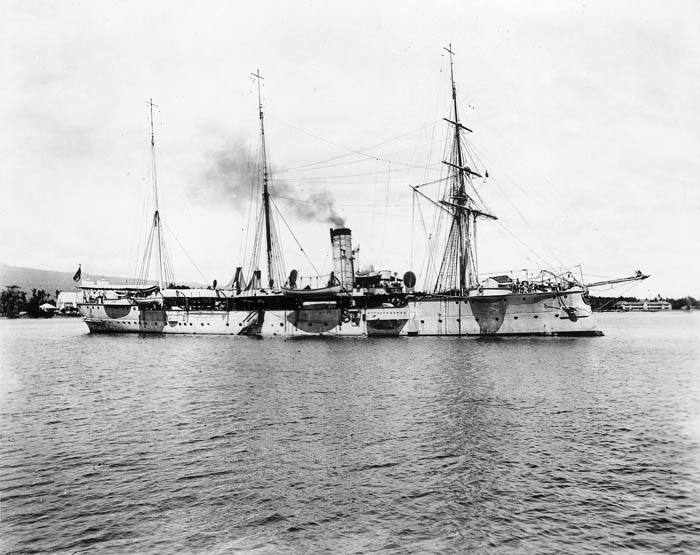
SMS Falke in Apia Harbor, 1900s, photo AJ Tattersall NZ
SMS Falke was ordered under contract name “D”, launched 4 April 1891 and christened by Princess Irene, wife of Prince Heinrich, then commissioned on 14 September, starting her sea trials. While off Bornholm she ran aground but was pulled free, decommissioned in Kiel in late October for fixes and repairs, recommissioned on 14 August 1892 and participating in the the annual fleet training maneuvers until September. She was then assigned to the 3rd Division with SMS Siegfried.
Falke then was tasked to join the German West African colonies and departed Kiel on 16 October, trplacing the gunboat Habicht. She was based in Dahomey, to witness the Second Franco-Dahomean War and by December, her captain unsuccessfully tried to negotiate the release of two German merchants held by Dahomean soldiers. Next she was in Duala, Kamerun, joined here by the gunboat SMS Hyäne.
As borders of German South-West Africa were negociated by treaty with Portugal and Britain the coast line had been not surveyed and alke was tasked of this, and notably to find a suitable port for the capital at Windhuk. She was underway from Luanda on 23 January 1893, sailed off Cape Cross and surveyed the area, discovering along the way a Portuguese padrão placed there by Diogo Cão in the 15th century. After some rest on 14-16 March she was back to Kamerun, and Duala on 29 April.
Next, she headed for Liberia on 27 May due to unrest, being off Monrovia on 9 June and hosting by security Joseph James Cheeseman, the President. She was back to Duala by 22 July and wasn sent to Cape Town for an overhaul, quicky recalled to deal with the Khoikhoi rebellion in German South-West Africa, on 5 December, and was sent back to Cape Town. Meanwhile, the Admiralstab transferred her to New Guinea and she departed on 23 December, stopping at Melbourne (8 February) and Sydney.
She met Bussard and Möwe in Austrlia and all three proceeded to Apia, Caroline, on 16 April, and started gunnery training. SMS Falke stayed in Samoa until early October and was sent in Sydney for maintenance, which became a lengthy overhaul in March-July 1895. Until 10 November she was based in Samoa, surveying Salua, north of tUpolu. The governor of the Marshall Islands requested her and she sailed to Kaiser-Wilhelmsland, Matupi Harbor (January 1896) to meet SMS Möwe and a new overhaul in Sydney until 15 April 1896.
Back in Apia she was recammed at the end of August to Auckland, NZ, with Bussard and Möwe to supress the rebellion in the Marshalls in early November 1896. She was overhauled again in Sydney (18 February 1897) and was in Auckland on 23 April, stopping in Tonga, then returned in Apia (16 May). When in June Curt von Hagen, the governor and other officials were murdered in Kaiser-Wilhelmsland, SMS Falke was sent to Stephansort, south of Madang, on 24 June to try to hunt for the murderers with a police detachment and contributed a landing party.
On 10 November she was back to Apia, and departed for Sydney via Auckland, also greeting a new crew from Germany. On 24 April 1898, she made another tour of German colonies and back to Sydney to greet her new commander, Korvettenkapitän Victor Schönfelder.
On 1 October 1898 she left Sydney for Apia, visited the New Hebrides, Fiji, and Tonga and made her long trip back to Germany alone amidst rising international tensions due to the crisis in Samoa. In March 1899, her trip was cancelled and she was back to Apia to deal with unrest on the island and catch the ring leader, Mata’afa Iosefo. There, there were already the USS Philadelphia and HMS Royalist, HMS Porpoise, shelling rebels. However as they proceeded, some of their shells hit SMS Falke by accident. Schönfelder prevented his crew to answer by gunfire, avoiding a more serious diplomatic crisis and the Second Samoan Civil War was resolved by separating them with the Americans and Britain receiving other concessions.
SMS Falke was soon relieved there by Cormoran and resumed at last her journey back to Germany on 1 July 1899, stopping in Sydney, Batavia, Colombo, Mahé, and Lisbon along the way to Hamburg (14 October). There, her crew conducted a landing exercise demonstration. Kaiser Wilhelm II greeted the captain for his management of the crisis in Samoa. On 27 October, SMS Falke was sent to be modenrized in Danzig, decommissioned on 3 November 1899 and taken over by Kaiserliche Werft.
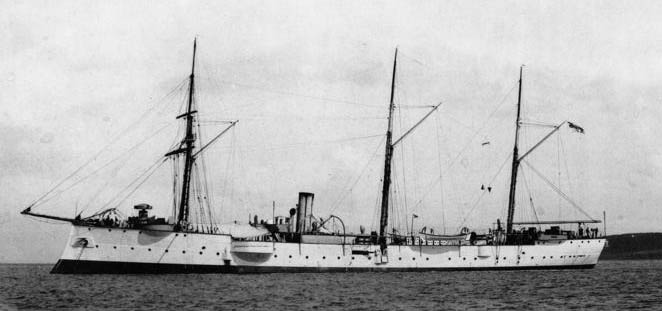
She left the drydock on 2 October 1901, and was reassigned to the Americas station. She joined SMS Vineta deasling with unrest in the Caribbean and South America, stopping in Saint Lucia on 14 November. She visited several ports and joined Moltke, Stein and Gazelle, later steaming up the Amazon River via the Pará River on 7 March 1902. She arrived in Manaus on 23 March, meeting several German steamers here but went on upriver, lacking accurate maps and river pilots, but reached San Ignacio, Peru on 17 April after an up riverine trip of 5,200 nmi (9,600 km; 6,000 mi). Coal shortage stopped her. Her rigging was not sufficient to resume the trip further, and she was back on 30 April at the mouth of the river, setting a record for German warships.
On 8 May, she was in Port of Spain, Trinidad before patrolling the coast of Venezuela during unrest and stopped en route in Fort-de-France, Martinique, to carry food and medical supplies to recuse displaced people after Mont Pelee eruption. She went to La Guaira, the Carúpano, Venezuela, protect German nationals and in June, evacuated German and French nationals to Saint Thomas. She was based later in Charlotte Amalie, Virgin Islands. She returned to Carúpano, La Guaira, and Puerto Cabello and visited Willemstad, Curaçao. On 30 September, she was in Port-au-Prince, Haiti, protecting German nationals during the revolution, later sending a landing party to protect the German consulate in Gonaïves.
The situation in Venezuela worsening, she patrolled off the coast, ready to protect foreign nationals. In December, she ran aground when leaving Willemstad but was pulled free. On 16 December, the East American Cruiser Division was established with flagship SMS Vineta (A Victoria Luise class cruiser). She was constantly patrolling during the Venezuela Crisis of 1902–1903 with British Royal Navy and Regia Marina vessels, compelling the Venezuelan government to make reparations over 10 years grievances started when a British merchant ship was boarded and its crew arrested.
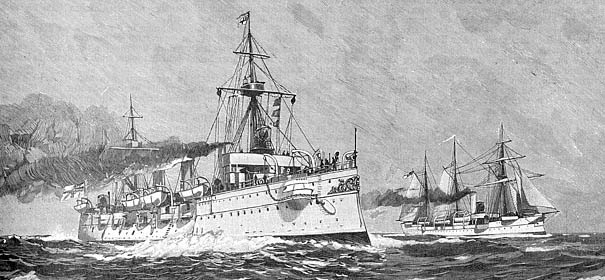
On 28 February 1903, Falke was sent for maintenance in the Royal Naval Dockyard, British North America, West Indies Station, Ireland Island (Bermuda) until 13 March. Until November 1905 she had a new CEO, Paul Behncke and in January 1904 visited New Orleans with Vineta, Gazelle, and Panther, then Newport News (26 May-16 June), and several Brazilian ports, in 7 July followed in September by Buenos Aires, rounded the Cape Horn, arrived in Peru and stopp ed along the way in several Chilean ports (like Valparaiso on 20 December 1904, spending Xmas there). However the the East American Cruiser Division was disbanded and in January 1905 she went to Colombia, and visited Central American ports until reaching San Francisco in June. On 10 July she went to Canada and southern Alaska.
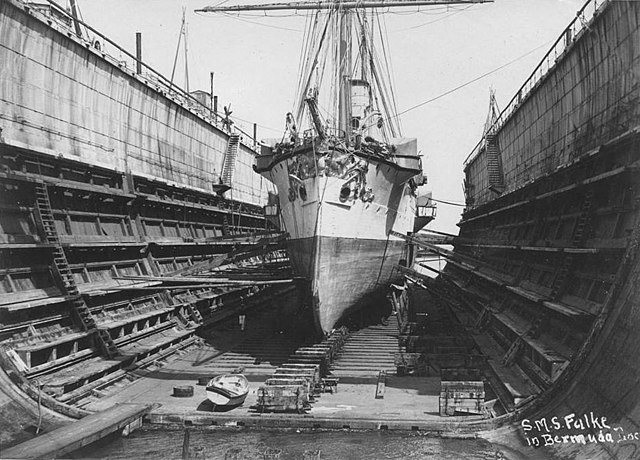
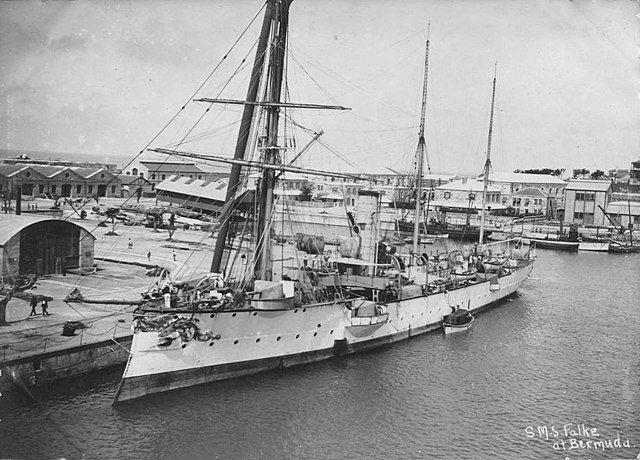
SMS Falke in the floating drydock and Great Wharf HM DY Bermuda 1903
On her return voyage, she toured the Gulf of California and spent Christmas in Mazatlán, Mexico, also stopping in Callao. While off Chile, she was damaged by a severe storm and was repaired in Talcahuano. After an earthquake struck Valparaiso she carriedthere food and medical supplies and stayed until 2 September. Back to Chile for the inauguration ceremony of President Pedro Montt (18 September) she completed repairs in Talcahuano and sailed afterwards to Punta Arenas, staying there until 15 December. Rounding the the cape to rejoin the Atlantic she was in Montevideo in January 1907, ordered there to come back to Germany.
She stopped in Dakar, Las Palmas, Lisbon on her way back, and was visited by Frederick Augustus III of Saxony before arriving in Danzig on 15 April, being decommissioned on 20 January, inspectors reporting she was too worn out for modernization or overhaul and she was stricken on 25 October 1912, BU at the Kaiserliche Werft in Danzig, after a colorful and busy career of twenty years.
 S.M.S. Seeadler
S.M.S. Seeadler
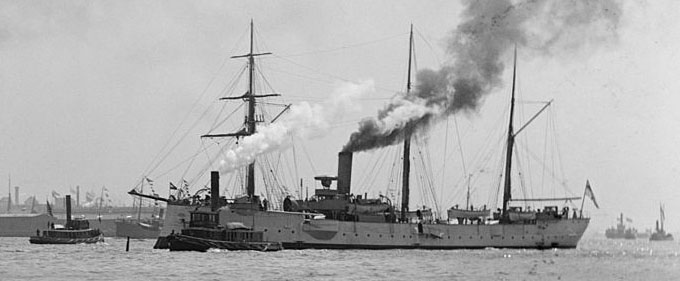
SMS Seeadler was launched at the Kaiserliche Werft, Danzig on 2 February 1892 (originally she was ordered as “Kaiseradler” or Eastern imperial eagle. It’s the shipyard director, Kapitän zur See Aschmann, ttat gave the launching speech and she was completed by 27 June 1892, renamed Seeadler on 17 August when commissioned since Kaiser Wilhelm II in between rename his first yacht ‘Kaiseradler’. Sea trials went on but on 25 October, she was accidentally rammed by the armored corvette Bayern in Kiel. She entered service on 15 March 1893 and was imediately setup for a long trip abroad.
She was to replace the older SMS Schwalbe in the East African Station, German East Africa. She steamed with SMS Kaiserin Augusta for a goodwill visit to the United States, for the 400th anniversary of Columbus’s first voyage, leaving Kiel on 25 March, but due to an error when supplying coal, she ran out while en route and was taken en route by Kaiserin Augusta to Halifax to be resupplied. The two reached Hampton Roads on 18 April, greeted by nine other navies, before heading for New York harbor, visited here by Pdt Grover Cleveland, impressed by her yacht-like appearance and lavish tropical wood fittings.
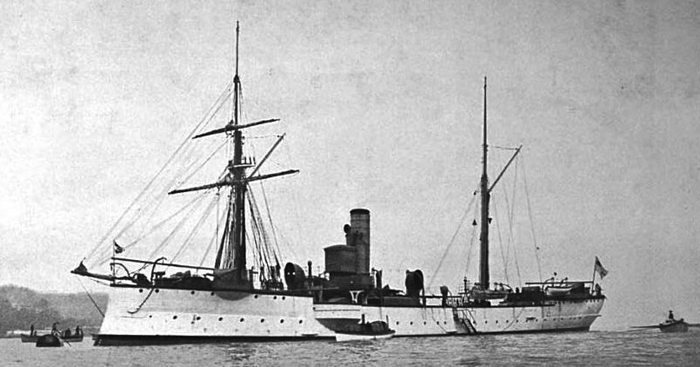
Next she sailed to the Azores, and the Mediterranean Sea, then Red Sea, meeting SMS Schwalbe in Aden on 20 June before the two proceeded to Bombay for routine maintenance until 21 August. Seealder arrived on station on 2 September 1893, in Zanzibar, meeting there SMS Möwe in the East Africa Station. On 9 September, they proceeded ti Kilwa to deal with a group of slave traders attacking a police detachment, and assisting the lack of colonial army (Schutztruppe) by sending a landing party to assist police troops. The slavers were shelled to submission and scattered.
SMS Seeadler headed for Lourenço Marques (Portuguese Moçambique) next to help dealing with a rebellion threatening German nationals, evacuated to Zanzibar (15 November). Möwe was ordered to New Guinea, but Seeadler was soon reinforced by Condor and Cormoran, the latter on her way to the Pacific, but remaining in the area temporarily. The three were also deployed for a show of force, to prevent British encroachment on Delagoa Bay, a supply port to the independent Transvaal.
In January 1895, Condor relieved Seeadler and she departed for Bombay to have her boilers repaired and cleaned up, plus a major drydock overhaul assisted by workers from the Kaiserliche Werft sent there in supervision. On 31 May she was back in East Africa, and was deployed again notably to watch the British Jameson Raid into the Transvaal (December 1895). It indeed threatened some 15,000 German nationals, there plus a 500 million gold marks investment there. The German governor called Seeadler’s landing force to protect the German consulate in Pretoria. However the Jameson Raid failed, but she remained until tensions cooled. By mid-February 1896, she was drydocked in Cape Town.
On 28 April she was sent in South-West German Africa, assisting Schutztruppe suppressing a local rebellion. She also was tasked to stopped British shipment of weapons to the rebels. She operated from Swakopmund on 5 May with the gunboat Hyäne, defending the city. Later that year she returned to East Africa, Zanzibar, taking aboard the deposed Sultan Khalid bin Barghash, carried to Dar es Salaam after the Anglo-Zanzibar War. On 20 December, she was back in Lourenço Marques to protect consul Graf von Pfeil, attacked by Portuguese colonial police. Condor joined her here on 2 January 1897 for a show of force. This was followedby her yearly overhault in Cape Town.

SMS Kaiserin Augusta and Seeadler in the US, 1890s
In May 1898, she was recalled to Germany, leaving Dar es Salaam for Aden (31 May), meeting Schwalbe which revieved her and was in Kiel on 26 June, later recommissioned for a major overhaul in Danzig. On 3 October 1899, recommissioned, she was ordered to reliev SMS Falke on the South Seas Station, German New Guinea. She departed Kiel on 19 October, stopped in Tangiers, forcing the hand of the the Moroccan government for damage to German interests there along the way, and arirved in south-Pacific colonies on 15 November.
Sh was first in the Admiralty Islands, 18 January 1900 show her guns after a European businessmen was murdered by natives, and started a tour of German holdings in the area, in Caroline and Mariana Islands recently purchased from Spain. In May she arrived in Samoa, meeting Cormoran there, touring the islands with governor Wilhelm Solf, and the Samoan chief, Mata’afa Iosefo. In July 1900, the Boxer Rebellion had her on her way to assist the suppression, arriving in Tsingtau, Kiautschou Bay concession joining the East Asia Squadron, with Fürst Bismarck and Hertha.
On 24 April 1901, she was back in Yap, Carolines, assisting the stranded steamer SS München, assisting with repairs to her hull. She was back to East Asia, patrolling Chinese waters and visited for the first time Japanese harbors until the end of 1902. On 2 January 1903 she was relieved by Bussard and was back to the South Seas Station, being overhaul in Uraga in Japan (3 August-14 September).
She became observer during the Russo-Japanese War, recalled to Tsingtau in case of hostilities involving Germany, with SMS Condor and the survey vessel Möwe. In early 1905 she made a goodwill visit to the Philippines and Dutch East Indies. On 28 June the decisive Japanese victory saw her sent back to the South Seas Station. Underway she was ordered to Africa while in Ponape on 20 August. She was requesting helping to quell the Maji Maji Rebellion in July. She ran aground twice (Labuan and Singapore) while underway, without serious damage and arrived in Dar es Salaam on 1 October.
In October she sent a landing party to Samanga, protecting the coastal telegraph line and was back in December ti Dar es Salaam, then sailed to Kilwa (17 January 1906) and back on the 24. She was overhauled at Cape Town and replaced SMS Thetis sent back to Germany. She remained in the East Africa Station until October 1907, under command of Korvettenkapitän Hugo Meurer, until June 1909, assisted by SMS Bussard in 1908. She sailed next to German South-West Africa, stopping at Walvis Bay and Swakopmund.
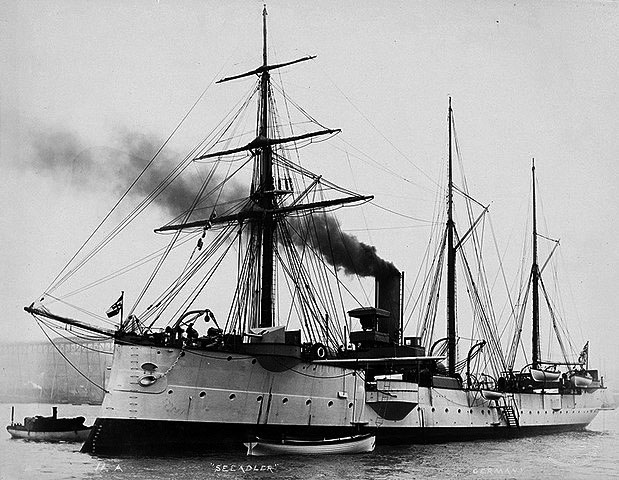
SMS Seeadler back in Germany, 1914
She cruised in these waters with the gunboat Panther in March-April before being back to Dar es Salaam, overhauled in Bombay. By early November 1911, she pulled the SS Irmgard free after running aground off Quelimane. She was visited in 1913 and 1914 by some notables. By 9 January 1914, she departed for Germany after 13.5 years abroad, a German reocrd for overseas service, relieved by Geier. She stopped in Aden and arrived Kiel on 18 March, then Danzig to be examined, judged in poor state and decommissioned.
On 6 May 1914 she became a gunboat and August 1914, to free her crew, reduced as an a unnamed hulk (The name was given to a famous corsair), storing naval mines, and later towed to Wilhelmshaven. While achored in the outer roadstead on 19 April 1917 she exploded, being destroyed, but there was no casualty. Her wreck is still there.
 S.M.S. Condor
S.M.S. Condor
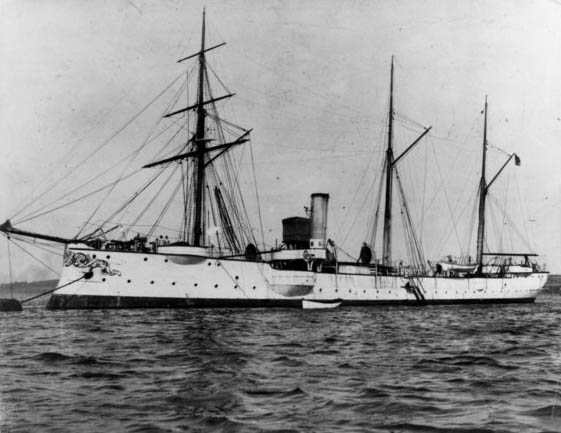
SMS Condor, date unknown
SMS Condor was ordered to replace the gunboat SMS Eber sunk by a hurricane in Apia in 1889, to Blohm & Voss shipyard, Hamburg. Her construction was stopped suring an outbreak of Cholera in Hamburg but she was launched on 23 February 1892, christened by Kaiserliche Werft director Kapitän zur See von Bodenhausen while the speech was given by Vizeadmiral Wilhelm Schröder, Baltic Station. She in fact accidentally launched herself due to the earlier tide and completed on 9 December, commissioned with trials started on 15 December.
On 2 October 1894 she was sent to German East Africa, Dar es Salaam station, relieving SMS Möwe. Her presence was also a show of force, to pressure Britain threatening the Boer Transvaal and Orange Free State in which Germany had strong interest. She indeed frequently moved back and forth between German East Africa and the eastern coast until 1899 especially after the Second Boer War broke out. She was also sent to Lourenço Marques (Mozambique, see above). On 27 June, she was with Cormoran in Delagoa Bay, later overhauled in Durban until 16 November, later relieving Seeadler.
By late December 1895 she was mobilized during the Jameson Raid into Transvaal. She was again in Lourenço Marques in January 1896. In June, she was in Mahé, Seychelles to rest her crew, called back to East Africa and in August-November was stationed off Cape Town, and then back in Mozambique at the request of the German consul, Count von Pfeilk, until 2 February 1897, with SMS Schwalbe. On 3 January 1901 she was back to Germany, stopping en route in the North Sea to help the German steamer Mawska.
drydock for an overaul of her hull and boiles she sailed two years later for the Pacific, relieving there SMS Cormoran at the South-Seas Station. On 26 June 1903 she stopped in Singapore and served with Seeadler and Möwe, converted as a survey ship. She helped quelling unrest in German Samoa and in May was in Sydney for a short overhaul. She carried the governor of German Samoa Wilhelm Solf on a visit to Hawaii until 14 September. By October 1907, she made gunnery training off the southern Ralik Chain, also a show of force for the local tribal chief.
With the gunboat Jaguar, she also dealt with unrest in the Marshall Islands until October 1908, carrying and deploying a contingent of Melanesian infantry to Pohnpei due to war between rival factions. By early 1909 she dealt with unrest in Apia, with Leipzig, Arcona and Jaguar. In August she tried to locate the lost government steamer Seestern on her way to Brisbane. Later she met the armored cruiser Scharnhorst, Nürnberg and Emden from the East Asia Squadron, back in Apia in July 1910. By January 1911 she was again sent to Pohnpei this time against the Sokehs Rebellion with Leipzig and Cormoran.
Until October 1911, she was in China, overhauled at the newly completed Kaiserliche Werft of Tsingtau. The Agadir Crisis in November saw her moved to Yap in case of war with France, and was sent later in maintenance in Sydney until 18 April 1912. Her survey staff was enlarged to map German protectorates. On 8 January 1913, she was reclassified as a gunboat after after overhaul in Tsingtao by May, she was judged in bad condition and ordered back to Germany, stopping to help the German steamer Zanzibar from hostile Moroccans after she ran aground.
Arrived in Danzig on 30 March 1914, she was decommissioned and thus, took no part in WWI. In 1916, she became a mine hulk off Friedrichsort, Kiel. Discarded in 1918, she was formally stricken on 18 November 1920, sold for BU on 8 April 1921, scrapped in Hamburg.
 S.M.S. Cormoran
S.M.S. Cormoran
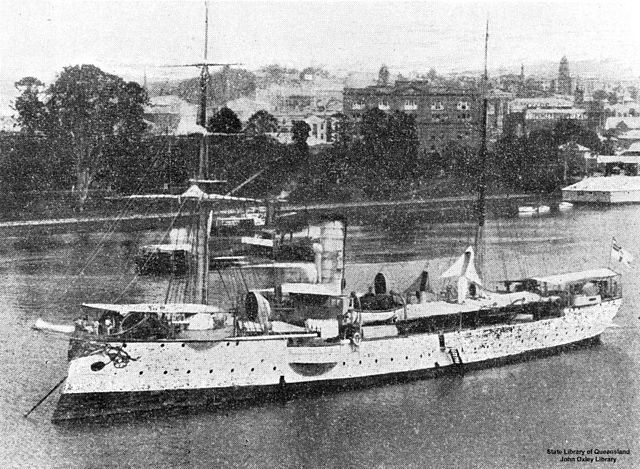
SMS Cormoran in Brisbane, Australia
SMS Cormoran emerged from the Kaiserliche Werft, Danzig and was trialled, then declared ready for service on 22 September. She was assigned like her sister to colonial duties, initially on 2 October to the East Asia Station, relieving SMS Wolf,but tensions in South Africa had her sent instead to German East Africa. On 16 October she left with Condor, stopping in Lourenço Marques, Mozambique, on 15 December, remaning there for seven months. In January 1895, she towed the stranded cruiser Afonso de Albuquerque back to Lourenço Marques.
In July, Condor arrived there to replace Cormoran so she was free to return to East Asian waters, stopping in Muscat (Oman) underay, visited by the sultan. On 5 August, while in the Strait of Hormuz she had a safety valve on ger starboard engine low-pressure cylinder damaged. She stopped in Bushehr, Persia for repairs. Next she resumed her trip to Basra via the Shatt al-Arab, being visited by the German consul and Turkish authorities. On 13 September 1895, she arrived in Singapore, East Asia Division under Rear Admiral Hoffmann (flagship SMS Kaiser).
In July 1896, she assisted the stranded gunboat SMS Iltis and by November 1897, steamed up the Yangtze River to Hankow, also assisting in the occupation of the Kiautschou Bay concession. She also was an observer during the 1898 span-am war in the Philippines (May 1898), being disuaded to close on Cavite by USS Raleigh. In November 1898 she towed SMS Kaiser from Samsah Bay (Fujian) to Hong Kong for repairs. Soon the situation degrading in Samoa prompted her to reinforce Bussard and Falke dealing with the rebellion.
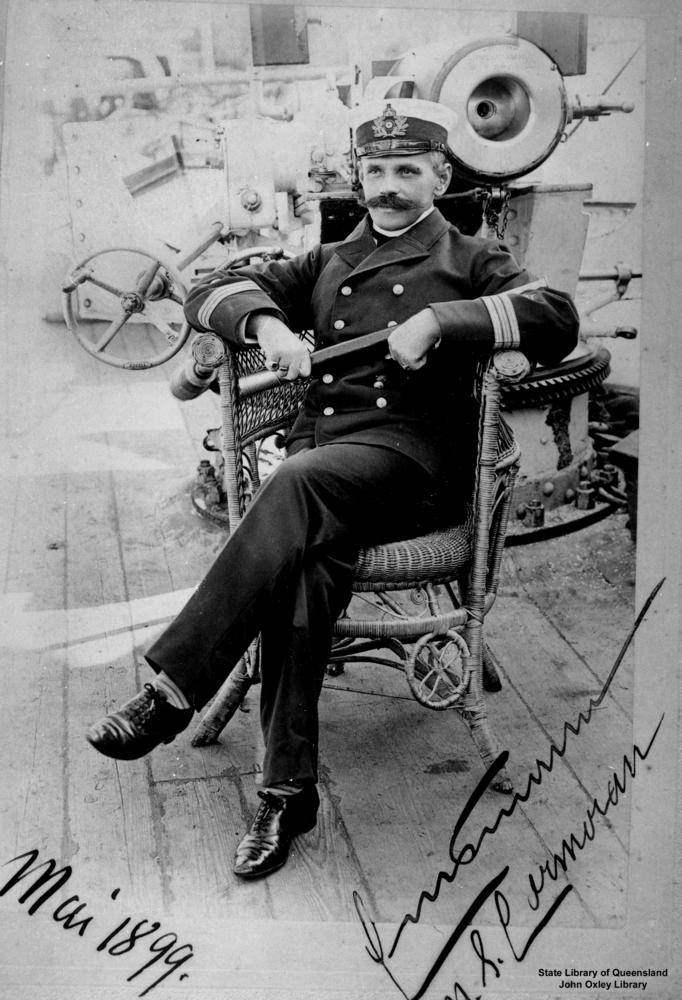
Captain H. Emsmann (State Library)
While en route on 23–24 March 1899 she ran aground on the Whirlwind Reef (north of New Pomerania), her bow sticking about a meter out of the water. She was lightened by removing coal and ammunition, but remained stuck and her captain Hugo Emsmann sent a steam pinnace and dinghy to Friedrich-Wilhelmshafen 162 nm away. They met the steamer Stettin and came back on 29 March. Again, all remaining coal and ammunition were either thrown overboard or deposed nearby, and and fore and mainmast were cut down, stern guns dismounted. At last she was able to float free. The crew re-stowed supplies ashore and moved to Friedrich-Wilhelmshafen, Tsingtau for repairs. This was instead done in Sydney, for a full dry-docking inspection, repaired going on untl June.
SMS Cormoran had later her crew replaced in China, as they were sent as a landing party deep inland to deal with the Boxer Rebellion. On 2 October, she was in Apia, starting a tour of German Pacific colonies. After her yearly Sydney overhaul, she teamed with SMS Hansa to represent Germany at the first Parliament of Australia, in Melbourne. She stopped in Samoa, and St Matthias Islands (Bismarck Archipelago) to punish the islanders after the searcher Mencke had been murdered with his assistant during his survey. On 28 July she was back to Apia and proceeded to make survey work around.
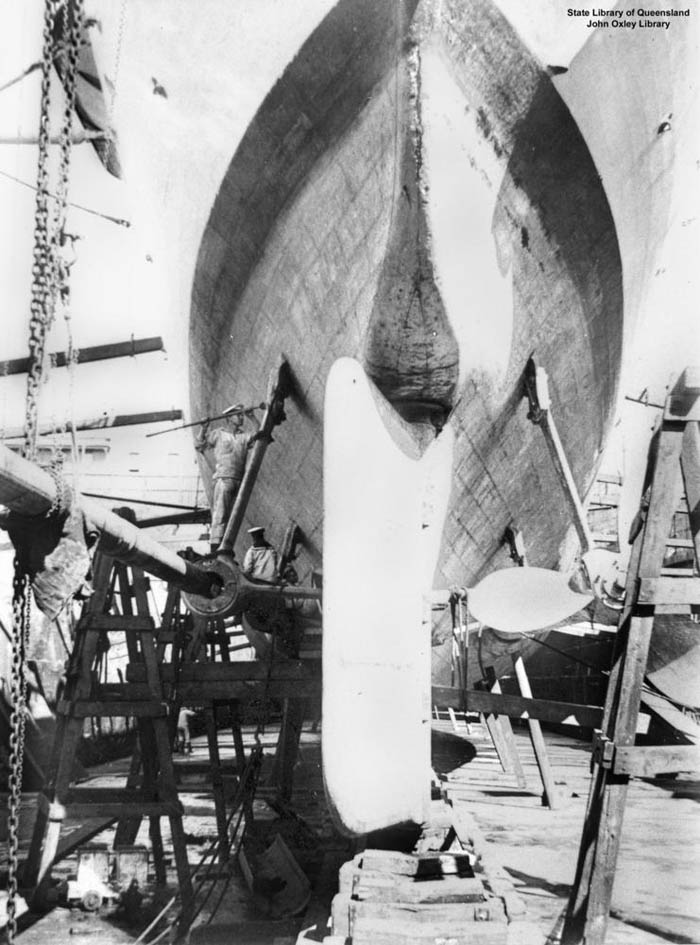
SMS Cormoran’s stern in drydock, Auckland’s drydock New Zealand
In 1902, she visited the Bismarck and Marshall Islands, making another tour of Pacific colonies from 23 September. While in Sydney by mid-March 1903, she was ordered back to Germany, arriving in Kiel on 13 September, seeing little service with the Hochseeflotte and later modernized in 1907-1908 at the Kaiserliche Werft, Danzig, notably obtaining brand new J W Klawitter boilers and having a lighter sailing rig, larger conning tower and bridge. By May 1909 she was recommissioned and setup to sail to the Pacific.
As she was in Malta on 8 June 1909, orders were received to move to Asia Minor due to unrest in Turkey, in particular against Armenians, joined there SMS Stettin and Lübeck, taking some 300 aboard. On 9 July, while in Port Said, she was ordered to resume her trip to the Pacific. SMS Cormoran stopped in Jeddah to repairs her boilers ad in the Pacific made a new survey cruise, while delivering landing parties and punitive expeditions against cannibals in Kaiser-Wilhelmsland. She participated newt to two ceremonies.
On 13 November, she carried the Herbertshöhe governor to Friedrich-Wilhelmshafen, Hansa-Hafen, and Kaiserin-Augusta River on a 183 nautical miles trip up river. On 22 November she was at the mouth of the river and in January 1910, was back in Apia. While underway to Hong Kong, she was hot by a hurricane, her sides pushed in by the massive waves, all of her boats destroyed or damaged. She stop in Nouméa, New Caledonia for short repairs, and was back in Hong Kong on 3 May.
On 15 July 1910 she was back in Apia, with SMS Condor, Scharnhorst Emden and Nürnberg, East Asia Squadron. On 13 December the fleet was in Rabaul and then Ponape, dealing with the Sokehs Rebellion. On 22 February, Cormoran, Emden and Nürnberg landing shore parties to support the Polizei-Soldaten from German New Guinea. On 23 March she went to Sydney for her overhaul and later resumed her colonial cruising duties, later assisting the steamer Planet pulling free the Norwegian barque Fram.
After a major overhaul in Tsingtau in May 1912, and a surveying cruise until 10 January 1913, she learned she was reclassified as a gunboat on 24 February. From 4 June to 5 July, she was overhauled in Sydney, stopping at Bougainville to deal with tribal feuds and landing a shore party. On 30 May she was back in Tsingtau. There in July, Fregattenkapitän Karl von Müller (SMS Emden) ordered her repairs to be accelerated and in August, Emden captured the Russian steamer Ryazan, brought back to Tsingtau, Cormoran being decommissioned and her crew transferred to Ryazan (plus some guns), becoming the auxiliary cruiser Cormoran, completed by men from the gunboats Iltis and Vaterland. The rest of the weaponry of the three shups was removed to strengthen the shore defenses, made ready for the attack on 6 August 1914. The ex-Cormoran was then scuttled in the harbor on 28–29 September 1914.
 S.M.S. Geier
S.M.S. Geier
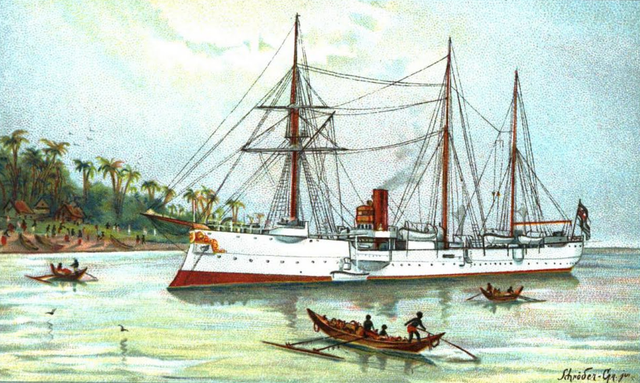
SMS Geier off shore postcard
SMS Geier was ordered under the contract name “F” and built at the Imperial Dockyard in Wilhelmshaven, launched on 18 October 1894, commissioned on 24 October 1895 and started sea trials, completed on 21 January 1896, decomm; and recomm. on 1 December 1897, assigned to the West Indies.
Prewar colonial duties: Carribean, China, East Africa.
The West Indies station was the least well protected colonial sector of the German Navy, until then using only school ships to protect German nationals here. With rising tensions in Haiti, the Admiralstab sent SMS Geier to the Caribbean, replacing the old ironclad Oldenburg, at first scheduled. The ironclad König Wilhelm, now rebuilt as an armored cruiser, was sent in addition. Based in Charlotte Amalie, Danish West Indies from 3 January 1898, Geier met later Charlotte and Stein, which were sufficient to deal with the Haiti insurrection, so that she dropped anchor at Santiago de Cuba until 6 April, before being ordered to visit Pernambuco, Bahía Blanca and recalled to Cuba with the Spanish–American War.
On 6 May, she was in Saint Thomas, to sail to Santiago de Cuba and San Juan, arriving there on 13 May, as observer of Admiral William T. Sampson attack. The US government allowed Geier to to evacuate twenty civilians of all nationalities to Veracruz. The captain of Zaragoza visited her for some practice torpedo launches, followed by the German ambassador, which in returned invited the crew to Mexico City, received by President Porfirio Díaz. On 16 June, Geier was in Cienfuegos in Cuba, and made two evacuations, in late June and eary August.
She visited New Orleans on 14 October, and was back to the Caribbean before resuming her tour of South America, typically stopping in ports having a strong German immigrant community. She crossed the Straits of Magellan on 20–23 February 1899 for Valparaiso, Callao, and eventually Panama then in May Puerto San Jose (Guatemala), settling financial disputes with the government. Next she stopped in Corinto, Guayaquil, Puntarenas, and due north to Canada via San Francisco for a boiler overhaul.
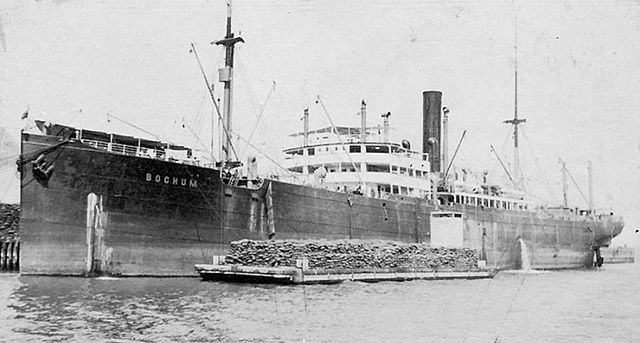
Geier’s collier Bochum of the DADG
On 18 September 1899, she she departed for Vancouver, via Esquimalt and started her voyage south, she was off Chile in January-February 1900, but was reassigned to the new West American station. While in Acapulco, on 9 July, she was called to sail to the Pacific to join the Eight Nation Alliance in the Boxer war. She stopped in Yokohama via Honolulu in Hawaii and arrived in Chefoo on 29 August 1900, patrolling the Bohai Sea and dropping anchor in Tsingtao by October. On the 28th she departed for Shanghai, based there until February 1901.
SMS Geier steamed up the Yangtze to Chungking, relieving Bussard and was back to Tsingtao, then returned this time in central China to relieve Seeadler and back to Tsingtao on 18 July. She then toured Korean and Japanese ports with SMS Fürst Bismarck. By October 1902, she reached the Dutch East Indies and Singapore. She was overhauled back in Nagasaki in March 1903 and later was formally assigned to the East Asia Squadron. By February 1904 she became an observer of the Russo-Japanese War, based in Chemulpo, captured by the Japanese. For her major overhaul, she was recalled to Germany, leaving Tsingtao on 14 January, arriving in Kiel on 16 March and recomm. in early 1911.
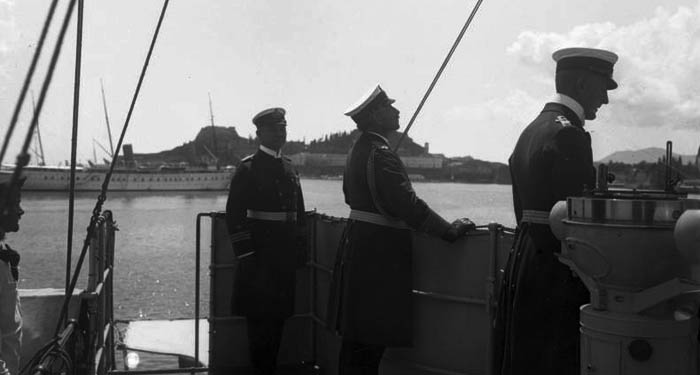
Kaiser Wilhelm II aboard SMS Geier
She was reassigned to relieve SMS Sperber on the East African Station, German East Africa, Dar es Salaam reached on 9 July and meeting there SMS Seeadler. Later she was recalled in the Mediterranean Sea, as the Italo-Turkish War had broke out, along with SMS Lorelei, based in Constantinople. She was also there for the aftermath of the Agadir Crisis (July 1911) and as back in East Africa, departing for Germany on 2 October via Piraeus (until January 1912), before being reassigned to the Mediterranean Division with SMS Goeben.
Until mid-July 1912 she provided humanitarian assistance in Libya, Palestine, and the Red Sea and escorted the Kaiser’s yacht Hohenzollern off Corfu by May. On 17 July 1912 she was overhauled in Trieste until 30 September. Next she cruised eastern Mediterranean ports and was in Haifa on 31 January 1913. There, a coal dust explosion killed two. In August she was ordered to replace SMS Breslau blockading Montenegro (Second Balkan War), staying there until 14 October and being overhauled again in Trieste. From January 1914, she was ordered back to the East Africa Station, surveying Tanga and by May, being reclassified as a gunboat. She was relieved by SMS Königsberg on 5 June and reassigned to the South Seas Station, relieving Condor.
The gunboat SMS Geier in WWI
Geier’s captain learned about the events while en route to the Pacific, stopping in Singapore on 25–29 July and proceeded through the Gaspar Strait, then receicing new orders off Batavia (1 August) to join von Spee’s East Asia Squadron at Yap. She adopted also along the way a commerce raiding stance, coaling at Jampea from Elmshorn and sailing through the Buton Strait, then coaling off Celebes with the steamer Bochum, now assigned as her permament collier.
Since she was worn out, some repairs were made to her engines and boilers until she reached the Palau Islands, under tow of Bochum to spare coal. On 20 August, she contacted SMS Emden, detached from the Squadron and in her own rampage. She instructed Geier to meet her at Anguar, but she could never be there in time, although Emden stopped and eventually met her at sea. Captain Curt Graßhoff met Emden’s cojnterpart to confer about the situation and next moves, and while Emden departed for the Molucca Strait, Geier proceeded back to Anguar, coaling from Tsingtau with the same instructions of reaching the East Asia Squadron in the central Pacific. She passed the Bismarck Archipelago, Kusaie, capturing on 4 September the British freighter SS Southport. She was not sunk but her engines were believed sabotaged. Instead the crew managed to repair them and sailed to Australia, reporting Geier.
On 11 September, Geier was off Majuro, missing the squadron. Her engines were so worn out after all these years she was unable to reach Tsingtao, already besieged by the Japanese. Options like commerce raiding or converting captured fast steamers as auxiliary cruisers were judged impossible and Graßhoff followed the East Asia Squadron to South America now at 8 knots, and towed along the way by the steamer Locksun into the Marshall Islands, with some maintenance done in 17-20 September.
The gunboat’s supplies were quite low to the point she was barely able to reach Hawaii, reached on 15 October, the Americans asking she was interned. In betwee, the battleship Hizen and armored cruiser Asama were patrolling the area and learned about the Geier’s arrival, taking albush positions outside the three mile limit. Graßhoff delayed the internment until 7 November, helped by the poor weather and pretexting repairs. However ultimately, the US Navy interned Geier. The crew was authorized to make it back to Germany.
As USS Schurz (1917-18)
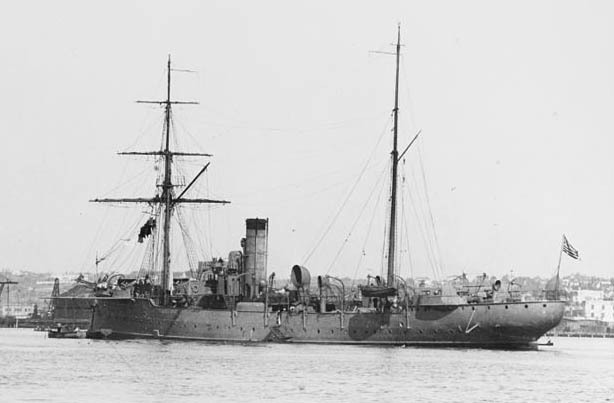
When the US entered war on 6 April 1917, Geier was seized, refitted for service in the USN as USS Schurz, recommissioned on 15 September 1917 (Captain Arthur Crenshaw). USS Schurz departed Pearl Harbor on 31 October to lead Submarine Division 3 in San Diego (K-3, K-4, K-7, and K-8) until December. She crossed the Panama Canal to Honduras. and in January 1918 carried the American consul from Puerto Cortes to Omao and anchored in Key West. She was based later in New Orleans and Charleston, drydocked for maintenance.
She was part of the American Patrol Detachment and patrolled for two months, between escort duties, even towing missions north and south of the Caribbean. While en rout for Key West at 04:44 on June 21, SW of Cape Lookout lightship, she was rammed by the SS Florida on her starboard side. The bridge was mushed in, the well and berth deck penetrated by 12 feet, as the bunker no.3, forward boiler room one killed and twelve injured. Crippled and flooded, she was abandoned and sank after three hours, struck officially on 26 August 1918.
Read More
Books
Clowes, William Laird; Markham, Clements; Mahan, Alfred Thayer; Wilson, Herbert Wrigley & Roosevelt, Theodore (1903). The Royal Navy
Gröner, Erich (1990). German Warships: 1815–1945. Vol. I: Major Surface Vessels. Naval Institute Press
Hildebrand, Hans H.; Röhr, Albert & Steinmetz, Hans-Otto (1993). Die Deutschen Kriegsschiffe
Gardiner, Robert; Chesneau, Roger & Kolesnik, Eugene M. (eds.). Conway’s All the World’s Fighting Ships 1860–1905
Marley, David (2008). Wars of the Americas: A Chronology of Armed Conflict in the Western Hemisphere. Santa Barbara
Nottelmann, Dirk (2020). “The Development of the Small Cruiser in the Imperial German Navy”. Warship 2020. Osprey
Nunez, Severo Gómez (1899). The Spanish–American War: Blockades and Coast Defense. DC: Washington, Govt. Print.
“Schurz”. Dictionary of American Naval Fighting Ships. Navy Department
Sondhaus, Lawrence (1997). Preparing for Weltpolitik: German Sea Power Before the Tirpitz Era.
Vego, Milan N. (1996). Austro-Hungarian Naval Policy, 1904–14. Frank Cass Publishers.
Links

On german-navy.de
CC photos
On historyofwar.org
On worldnavalships.com
Notes on the spanish-am war
wiki

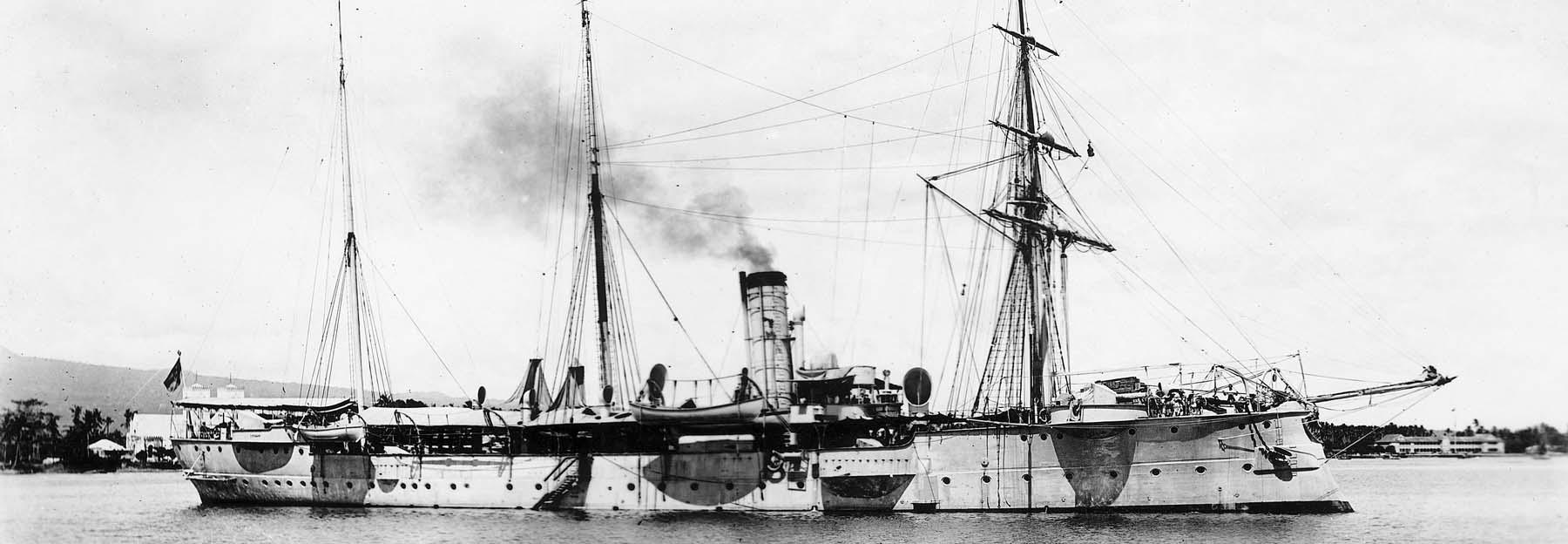

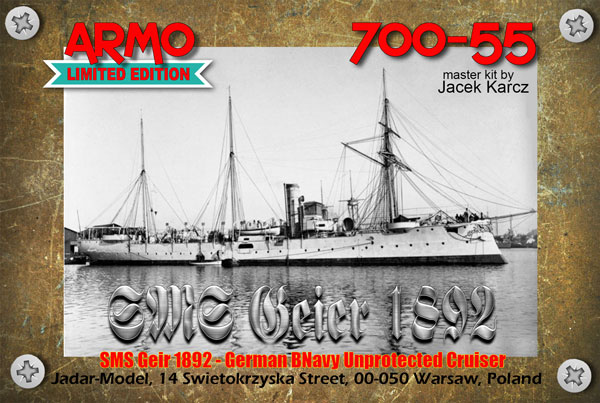
 Latest Facebook Entry -
Latest Facebook Entry -  X(Tweeter) Naval Encyclopedia's deck archive
X(Tweeter) Naval Encyclopedia's deck archive Instagram (@navalencyc)
Instagram (@navalencyc)





 French Navy
French Navy Royal Navy
Royal Navy Russian Navy
Russian Navy Armada Espanola
Armada Espanola Austrian Navy
Austrian Navy K.u.K. Kriegsmarine
K.u.K. Kriegsmarine Dansk Marine
Dansk Marine Nautiko Hellenon
Nautiko Hellenon Koninklije Marine 1870
Koninklije Marine 1870 Marinha do Brasil
Marinha do Brasil Osmanlı Donanması
Osmanlı Donanması Marina Do Peru
Marina Do Peru Marinha do Portugal
Marinha do Portugal Regia Marina 1870
Regia Marina 1870 Nihhon Kaigun 1870
Nihhon Kaigun 1870 Preußische Marine 1870
Preußische Marine 1870 Russkiy Flot 1870
Russkiy Flot 1870 Svenska marinen
Svenska marinen Søværnet
Søværnet Union Navy
Union Navy Confederate Navy
Confederate Navy Armada de Argentina
Armada de Argentina Imperial Chinese Navy
Imperial Chinese Navy Marinha do Portugal
Marinha do Portugal Mexico
Mexico Kaiserliche Marine
Kaiserliche Marine 1898 US Navy
1898 US Navy Sovietskiy Flot
Sovietskiy Flot Royal Canadian Navy
Royal Canadian Navy Royal Australian Navy
Royal Australian Navy RNZN Fleet
RNZN Fleet Chinese Navy 1937
Chinese Navy 1937 Kriegsmarine
Kriegsmarine Chilean Navy
Chilean Navy Danish Navy
Danish Navy Finnish Navy
Finnish Navy Hellenic Navy
Hellenic Navy Polish Navy
Polish Navy Romanian Navy
Romanian Navy Turkish Navy
Turkish Navy Royal Yugoslav Navy
Royal Yugoslav Navy Royal Thai Navy
Royal Thai Navy Minor Navies
Minor Navies Albania
Albania Austria
Austria Belgium
Belgium Columbia
Columbia Costa Rica
Costa Rica Cuba
Cuba Czechoslovakia
Czechoslovakia Dominican Republic
Dominican Republic Haiti
Haiti Hungary
Hungary Honduras
Honduras Estonia
Estonia Iceland
Iceland Eire
Eire Equador
Equador Iran
Iran Iraq
Iraq Latvia
Latvia Liberia
Liberia Lithuania
Lithuania Mandchukuo
Mandchukuo Morocco
Morocco Nicaragua
Nicaragua Persia
Persia San Salvador
San Salvador Sarawak
Sarawak Uruguay
Uruguay Venezuela
Venezuela Zanzibar
Zanzibar Warsaw Pact Navies
Warsaw Pact Navies Bulgaria
Bulgaria Hungary
Hungary

 Bundesmarine
Bundesmarine Dutch Navy
Dutch Navy Hellenic Navy
Hellenic Navy Marina Militare
Marina Militare Yugoslav Navy
Yugoslav Navy Chinese Navy
Chinese Navy Indian Navy
Indian Navy Indonesian Navy
Indonesian Navy JMSDF
JMSDF North Korean Navy
North Korean Navy Pakistani Navy
Pakistani Navy Philippines Navy
Philippines Navy ROKN
ROKN Rep. of Singapore Navy
Rep. of Singapore Navy Taiwanese Navy
Taiwanese Navy IDF Navy
IDF Navy Saudi Navy
Saudi Navy Royal New Zealand Navy
Royal New Zealand Navy Egyptian Navy
Egyptian Navy South African Navy
South African Navy






























 Ukrainian Navy
Ukrainian Navy dbodesign
dbodesign